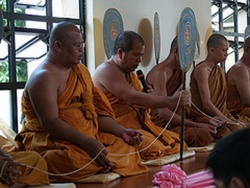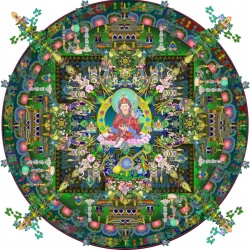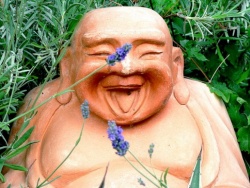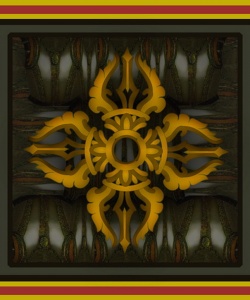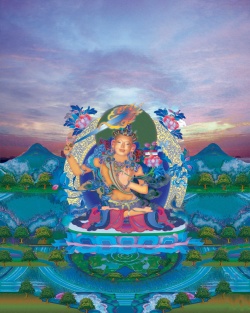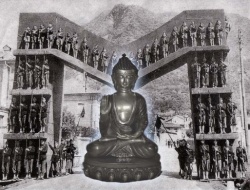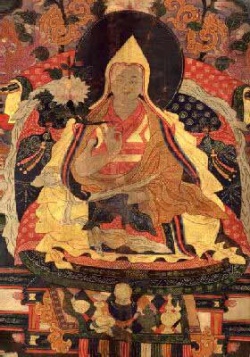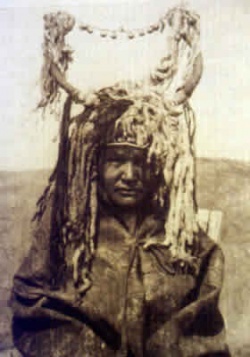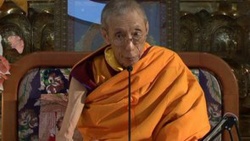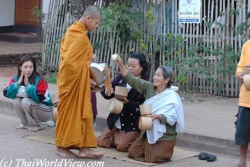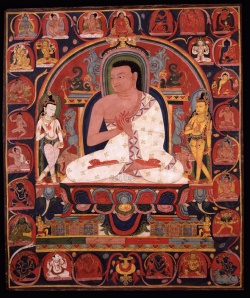Karma and non-duality
Aaron: (beginning 5 minutes are lost due to faulty recorder; Aaron has been speaking of karma and the resolution of karma, as seen in the body) When the advanced practitioner dies, he is left sitting in a room in a small house or room, closed, sealed. Normally the body would rot because the body has impurities... That’s part of what leads the body to rot when it’s no longer alive, It’s dead meat, in a sense. The mind also has impurities. Impurities and karma are not the same thing. Impurities are impurities and karma is the result of the impurities. When the impurities are completely resolved, the body simply dissolves, literally. When people outside watch that room, they see rainbow lights shining out of the room, and at the end of the week when they go in, all that’s left of the body is the hair, fingernails and toenails. Those are the only things that don’t completely resolve, not because they have impurities but simply because of their content. Hair and fingernails do not carry karma. They grow and fall off, so they remain.
This being is an Arahant, who has completely resolved everything. When there is karma, it continues to bring you back into a new birth.
This may sound extreme. You may be thinking, “I am not yet capable to do that." And you’re probably right! That’s not a problem. Our concern here is not to turn you into Arahants overnight but rather to help you understand the experience of karma in the body, the energetic physical, and mental experience of karma in the mind and in the body, and to learn how to release it.
The release will pick up speed as you practice with it. You’ll hold on to less and less karma. This is a practice that will be relevant for you at the time of your death, not after you die so much as while you are dying. Lying there and seeing the places of fear and contraction, you mingle them with light and space. It’s basically a practice of non-duality. There is that contracted level of the body and mind, there is the uncontracted level, and there is, as SW pointed out in her notes, that which is beyond contraction and non-contraction. When you know yourself to be that which is beyond contraction and non-contraction, the movements of contraction and non-contraction cease to matter. They cease to matter before they cease. You rest in that space of knowing that you are that which is beyond it all, and that knowing stops any contraction around the arising contractions. Contractions still arise. Awareness watches them arise, watches them pass away.
Sometimes contractions arise in balance, as with the breath, and the balanced contraction as the breath comes in and goes out. The heartbeat arises as balanced contraction; there has to be a contraction for the heart muscle to beat, but there’s no concern about that contraction. But if your heart suddenly started to beat in an unusual way, out of rhythm, that irregularity would cause concern, and a contraction around this unusual contraction. And then the pace of fear builds up.
At any point you can stop it by stepping back into that space of the one who is beyond contraction and non-contraction. It doesn’t mean that there’s no longer concern about the heart that’s beating out of rhythm, but it’s a kind concern that says, “Ah, so, look at this. Unusual. Maybe we’ll have to call an ambulance." But the calling doesn’t come from a place of tension and fear. Even if it does, when you rest deeply in that place Ajahn Chah called “the one who knows," when you rest deeply in that place, beyond contraction and non-contraction, you not only do not create new karma but there is the complete release of karma which has been--you’re going to have questions about this--which has been illusion from the start.
Let me try to give you a metaphor that will explain this. Suppose I give you all some stage make-up and told you to make yourselves up so that you are not identifiable anymore, so that you were completely a different character. Color your face, age your face and put on costumes. And then I ask you to be in the role of the person you have made yourself up to be. (Said in old voice) Be somebody very old, the face looking haggard, the voice carrying that age. (Normal voice resumes) To play it convincingly, you have to believe that’s who you are, or you can’t convince anybody else.
You have put yourself in the guise of a very old person and you really believe that’s who you are, and then the building catches on fire. You have to get out quickly, but you can’t because you’re 97 years old! But in that moment you wake up and recognize, “that was just a part I played," and right then you’re free of being 97 years old.
Karma works the same way, to some degree. As soon as you recognize that you have brought this whole illusion of karma in to the mind and body and have been living it out for lifetimes, for eons, there’s a certain release of it. Release of karma and balancing of karma are 2 different things. It’s released; it was illusion, and yet because there was a relative level of it, it still must be balanced. You do not have to do the balancing within the lifetime. You can; you do not have to.
So, at this point instead of being an Arahant with it, you might be a non-returner. You do not have to balance it within the human situation. But the karma that draws you back into a new birth is gone.
Karma is also stored in the cellular tissue of the body. Many of you can identify one weak area of your body, that’s been weak since you were young, an area that’s more susceptible to injury such as the knee, the back, the eyes, teeth. This is karma stored in the cellular tissue of the body. These also can be released. Part of what brings you back into a new birth is that the body itself is pulling itself into the same old distorted form. When there’s no longer that pull, the body doesn’t need to come back. The mind pulls itself into a new birth; the body pulls itself into a new birth. Both can be released.
The practice I want to teach you today is a first step toward that release. When I say a first step, today it will bring release but of course it’s taken you so many births to build up this karma and there’s much to be released so you can’t expect that you’re going to release it all in one day. But you may release something significant today as you practice with this.
I want to shift here and talk for a moment about the dzogchen tradition. In the Tibetan tradition, dzogchen is the highest practice. So first there are the basic ngondro practices, as you do with your vipassana. The spelling is “n-g-o-n-d-r-o." These are the basic mindfulness practices and so forth. But it is recognized in that tradition that resting in awareness takes you to that place beyond contraction and non-contraction, to a place that’s able to watch everything without building in the stories of the self.
These teachings are not just for Tibetans, of course. Many within the Theravada tradition are now teaching with the use of Pure Awareness. It’s a helpful tool. When I read some of Ajahn Chah’s writing and the way he speaks of the “one who knows", it’s clear to me that what he’s talking about is the one who rests in Awareness. It’s no different; it’s just a different language.
Most of you have learned the basic dzogchen practice of alternating resting in rigpa and analysis. This is the practice where something arises and it pulls you out of rigpa – there’s a loud noise or some other object that pulls you out of that place of awareness, – you ask whatever question has worked for you, “what is it?" or, “anything here that’s not an expression of the Unconditioned?" You ask the question. As we’ve demonstrated it, as you ask the question, the wisdom mind comes in. Space opens up. It’s as if you’re looking close and you step back to see it for what it is again. We don’t have to call this dzogchen, it’s simply the mingling of wisdom and awareness. I’d prefer not to call it dzogchen; just Pure Awareness practice, non-dual practice.
When you are very present with something, let’s say that you are resting in spaciousness and suddenly a raccoon runs across the floor, you’re startled. It runs over your feet. What is it? You have been in a very open space, present, seeing this creature without seeing it as something separate or different, and then suddenly it runs across your lap and you are startled by it. You pull out of this non-subject-object consciousness. Fear comes up, what is it? Is it a rat? Is it a chipmunk? What is it? Is it dangerous? What is it? As you bring attention to it, looking at it, what is it? What is it? Suddenly you recognize it’s just a living creature, a small sentient being. There’s space again. We don’t have to call this dzogchen or vipassana, doesn’t need a name.
Or it may work that there was that moment of separation, then relaxation into, “just a creature," but there is separation form yourself because the body still reverberates with “startled." What is it? What is this trembling, contraction or tension? Anything “other than"?
You talked a lot last night about being present with objects and whether just awareness is enough to bring liberation. You talked about how when something is very painful, playing on old conditioning, you’re pushed out of that centered space and are unable to hold that wide spacious presence because you’re shaking with the presence of this object, whether it’s somebody’s anger with you or with body pain or whatever it may be. There’s not the ability to rest in that one who knows. The small personality self has become predominant and it’s trying to figure out, “How do I fix this? What do I do?"
With enough practice, awareness starts to note, “Trembling, fear," and if it knows how to work with fear, slowly the space grows. So the dzogchen practice gives you another tool to work with it through the repeated recognition that there is nothing here but another expression of the Unconditioned. This anger is an expression, this fear is an expression, and this self-judgment is an expression. I don’t have to be concerned about it. Return to that space of balance.
Most of you have found at least some degree of success in working with this. You have learned to work with this practice to the point that when you are sitting with your eyes open doing dzogchen practice and something shakes you out of that space, you’re aware, “I’m no longer in rigpa; the everyday mind is predominant. What is it? Anything separate here?" and watch tension dissolve and mind come back into that space. Few of you can stay stably in that space for a length of time, but most of you have learned to hold that space in a meditation practice, and return to it again and again. And you have found the power of the practice that allows you to hold that space.
But things still pull you out, yes? Anybody who doesn’t get pulled out?
In the Tibetan tradition the practice you have learned/ are learning is given the name trekchod, cutting through; The practice that may follow trekchod is called togyal. The beginning of togyal practice is the practice of mingling whatever has come with light and space until it dissolves and it is clearly seen, “There is nothing there that’s solid; there never has been."
Remember that I do not teach you trekchod or togyol; I teach related practices but I am not a Tibetan teacher and these may be quite different in articulation than such a teacher would use. You will find the end result the same.
As we do trekchod-like practice, it has the effect to, let us say, wash off that stage make-up I had you put on 10 minutes ago. You look in the mirror and instead of seeing the 97-year-old, you see “Ah, this is make-up on the outside. I’ve can wear it when I like but I can also wash it off. I don’t have to create a self-identity with it." But there is still a doer, one who releases the make up, the self, so there is still some layer or self awareness.
The togyal-like practice has a further effect. It breaks through residual self-identity, and thus, it brings you to the place that’s free of karma because the karma exists only in the self-identity.
First let me hear any questions about what I’ve said so far, and then we’re going to do some meditation together. I’m going to teach you the basics of the practice and then ideally send you off to the woods, lake, sky, and the earth, to do some practice with it. Any questions about what I’ve said so far?
Q: It seems to me that this practice sounds like a kind of fluid movement between meditation practice and a contemplation practice.
Aaron: I think that’s accurate. It’s got one more step, between meditation and contemplation, non-meditation. Non-meditation is simply that place of resting in. Once you’re there, there’s no longer meditation, there’s just pure being. But when something shakes you out of true being, then there’s the contemplation, what has pulled you out, the meditation that is the passageway back into pure being, and then resting in pure being.
Q: About the practice of asking, “Is there anything here other than the Unconditioned?" What about people who are living with terrible conditions, bombing of their homes in wartime? Is this just a nice practice for easy living?
Aaron: Not at all. I first learned this practice in a lifetime in which the being that I was experienced terrible suffering and deprivation, terrible abuse by those who had enslaved me, by those who killed my neighbors and my loved ones. It was more challenging. It’s more challenging to look at a murderer who is holding a gun at your head and say, “Not other-than," but if non-duality is a truth when it’s peaceful, it’s a truth when it’s violent. Nothing other-than.
This was a lifetime of great progress toward freedom for me. The lifetime ended in a brutal way, first watching my family killed and then being killed myself, cruelly killed. I’m not saying just because it’s not other than, there’s not a compassionate resistance. It’s not compassionate to allow someone to kill you. Bad karma for them! I did resist. I did what I could to protect my family. We had hidden in a cave. We were found, pulled out and killed with sharp swords, knives. There’s a choice. Once it’s beyond me to save my family and myself. I can die with hatred and separation and know that’s going to bring me into a new lifetime based on that karma at the moment of death. I can hold hatred against the ones I see killing my children. Or I can release hatred, seeing the hatred also is not other-than. It has arisen out of conditions, it’s based on fear. Just as that which is beyond contraction and non-contraction observes them both, that which is beyond love and hatred observes them both. It’s a place of perfect peace, deep wisdom, that sees these “others" acting out of their conditioning, just as the human that I was, was acting out of my own conditioning. This is the trekchod practice. At that moment there’s nothing to forgive, there’s just compassion for the human condition – the word “condition," I wish there was another word for it. The human situation in which the conditioning keeps playing itself out – and shifting into that spaciousness which is completely non-contracted. At that stage, compassionate awareness sees the human tension, pain and struggle. Then the togyal practice in which that pain and fear is merged with light and space until it all dissolves. There is no longer any doer, nor anything to be done, just clarity and compassion.
This paved the way for the following lifetime in which the being I was became completely realized, free of need to return. So there still was some karma left at the end of that lifetime that drew me back into the new lifetime, but it prepared the way for the next lifetime in which there was liberation. I don’t think it could have happened in that way had there not been such trauma at the time of death. But also, I had prepared for this all of my life, for this end of my lifelong practice.
I lived in a part of Tibet where there was some invasion by neighbors who were warlike people, wanting conquest over others. So it was a very difficult time. It was very powerful.
I am not saying it’s easy, but remember you are not here for comfort and convenience, you’re here literally to become liberated, but to become liberated doesn’t mean just not to have to come back, to become liberated means to learn to hold this place of love and non-duality irregardless of conditions. Because once you have learned that, then you are able to move on to the next phases of your growth and nothing can shake you out of it. Only then can you truly be of support to other beings that are caught in violence, hatred, and fear. Whether you choose to come back as the bodhisattva or whether you serve as I do now from the spirit plane, you are able to hold that space of love. Are there questions?
Q: In dzogchen, seems that there are no concepts, just hearing, just seeing, just feeling, just awareness. Would it be correct and true to say that it is a subtle contraction whenever concept should arise? For example, resting in dzogchen practice and here is raccoon is just seeing. When concept “raccoon" arises, is that a subtle contraction out of resting in rigpa?
Aaron: You’re correct, Q, that the concept and separation arise together. When there is the concept that labels something, it labels it that way out of the sense of separation. I said they arise together. One might come first, but so quickly on the heels of the other that they seem to arise together. However, at that moment, if there is separative consciousness, because that’s really what it is, as soon as there’s this “other," there’s a self. Separating. As soon as the separating is seen as simply arisen out of the flow of conditions, not other-than in the sense that it comes from somewhere else, it’s just the outflow of conditions, you’re right back in awareness.
To take it a step further, with that separating there’s usually contraction in the energy field or in the body. It’s sufficient simply to observe, “Contracting, contracting." Who is contracting? What is this contraction? It’s just the outflow of fear and the conceptualizing habit energy.
Ignorance is simply the manifestation of the dualistic fixation. Three words pertain to ignorance: avijja is the Pali word translated as ignorance. Avijja is comprised of moha, which is delusion of a separate self, and annana or non-knowledge. So those two combined words, delusion and non-knowledge, are ignorance. They interrelate so it’s never just one or the other. Delusion sees the world as duality; self and other. It grows out of fear which solidifies self. Non-knowledge begins as the non-knowledge of all phenomena as manifestations of Pure Mind. Thus, it is also fixated in duality, the dualities of light and darkness, good and evil, Pure Mind and not pure mind, and so on. Annana may be read as simply something you haven’t met yet, and yet you may already know it in the wisdom of the heart, but fear creates unwillingness to acknowledge that knowing. Both come together for the word avijja. Please understand that this is an oversimplification.
So moha is the habit energy of that aspect of ignorance that is deeply grounded in the idea of a concept of separation. Not just separate self, but duality. When you practice in such a way that it continually keeps cutting through the concept of duality each time it arises, eventually you shift it. This duality is just a concept you keep creating and creating, over and over again. It’s just habit energy. You don’t have to do that any more. And then there’s Awareness. Connected, nothing separate.
Let us work with the practice up to this point, and there will be time for questions later. What I would like us to do is to move outside onto the front porch where you have a view of the sky and water. Bring your folding chairs out… and I’m going to lead you in a guided meditation. I’m going to return you to Barbara now for a moment so she can explain the plan for the day. We’ll go out there and I will come back into the body and lead the guided meditation. I return the body to Barbara.
Aaron: I understand that you all need to work with this more. Rather than giving you 10 or 15 minutes to practice and then new instructions, I’m going to give you a series of instructions and ask you to take them one at a time into your longer practice period.
The first instruction is to see the non-separation of the elements, to allow the elements in the world around you to mingle with each other and with space and light. You have read this in the previous transcripts (Emerald Isle, May 2006)
After you have practiced that and feel somewhat stable at it, begin to work with the elements within the self, I would ask you to bring forth an unpleasant memory of the last day or two, something that was emotionally or physically painful, a place of anger, sadness, or confusion that brought contraction. Bring this memory into your mind and see if you experience the heavy density of it. The memory probably creates a knot somewhere in your body, a knot of anger or sadness or fear. What I want you to do first is to identify this heavier space through feeling of it, through hearing it, through seeing it, even by tasting it. Take your time.
(pause)
It may seem subtle, just an area of contraction, an area of tension that feels heavier in the energy field than the rest of the energy field. Most of you have found such. If not, then just listen to the instructions and work with it later.
Holding this knot, this heavier, darker or denser aspect of being, in the same way that you allowed the elements to mingle in the earth around you – the earth, water, air, and fire, with space and light—in the same way, allow this heaviness to mingle with light and space.
You are not doing or creating anything. When I say, “you allowed the elements to mingle," you allowed yourself to see the truth of the intermingled elements. You did not mingle them, they’ve always been mingled. You simply allowed yourself to see it. In the same way, allow yourself to see the space and light within this dense knot.
This is what I would call karmic knot…
You are not fixing it, you are simply coming around to look at it from another side. From one side it looks solid. If you could picture a round disk, a hoop, covered with a screen material, a mesh, if you look at it from one side you’ll see a solid straight line but as you come around 90 degrees, you see that it’s just a hoop covered with mesh, nothing solid at all.
As we spoke of last night, your primary tool is the skillfulness to attend to that which arises and pulls you off balance, to attend to it with kindness by which I mean to bring attention to it, and to work with it in whatever way is skillful to invite centeredness. In the same way, take this knot that you have seen and attend to it by seeing that this knot that seems so solid is not solid. As I have phrased it earlier, as this 97-year-old face that’s covered with make-up and age lines and so forth is not all it seems. It’s just painted make-up. The knot in a sense is just painted make-up, painted by your old conditioning. Allow yourself to see it expressing, mingled with space and light and watch what happens to it. If and when it goes, simply rest in spacious awareness.
Again I will be quiet for a few minutes…
(pause for several minutes)
That is essentially the practice for now. I know you will have questions. Unless there are pressing questions now, I would prefer you simply go off and try it and then you can bring your questions to me based on your experience. Especially I would like you by the water or on the water. You do not have to immerse yourself in the water although you’re welcome to. Use a boat or choose a seat on the shore where you can see the sun rippling in the water. The elements in the earth simply serve as reminder of the energy and the elements moving through yourselves, for of course the same elements that are here in the earth around you are here in the self.
The karmic knot does not relate specifically to the elements, the elements are simply an area where it’s easy to see the knot. This is akin to the fact that you cannot see water vapor but when you look up and see a cloud you know there’s water vapor there because it’s pulled into a dense collection. So in a cloud you can see water vapor. In the elements you can see the knots. In the same way you can experience the denseness, habit energy, karma, contraction, it’s a mix of all of these things. Just as that which is beyond contraction and non-contraction observes contraction and non-contraction, so that which is beyond contraction observes it within the self and within the karmic knot. You deepen in insight that what you most truly are, is that which is beyond it and not the karmic knot itself. . The karmic knot is at some level an illusion and you don’t have to be caught up in it anymore. It’s really as simple as that.
It is a tremendously liberating practice. As you work with it, after you begin to understand it, bring in something that is truly difficult for you like an ongoing feeling of shame or unworthiness and watch how it yields to this practice. It’s very powerful.
